LongHouse Reserve weaves gardens and sculpture: Dune path, pavilion, and tropical rill
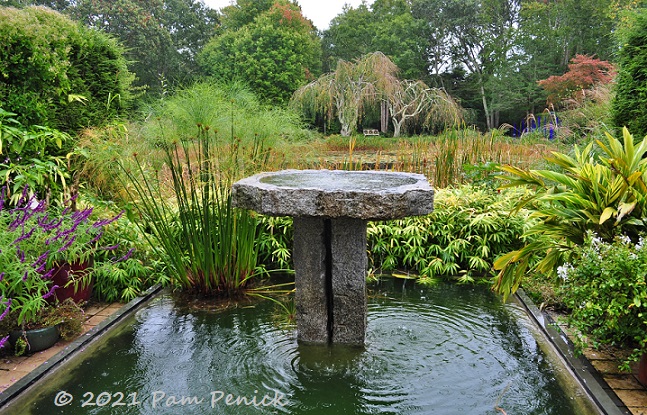
My visit to LongHouse Reserve on October 10, a cool, drizzly afternoon, was almost an afterthought. I’d detoured through the Hamptons on my Northeastern road trip largely to visit Madoo, garden of the late artist Robert Dash. With two days to fill in the Hamptons I did a little online research, and LongHouse in East Hampton sounded intriguing — not to mention covid-safe being outdoors. I understood it to be a sculpture garden — all well and good. But as I discovered immediately upon entering, it’s so much more.
LongHouse Reserve is a harmonious marriage of gardens and art, woven together with creativity and humor by its master-weaver and textile-artist creator, the late Jack Lenor Larsen. Revered in the world of textile design, Larsen made his Hamptons home and 16-acre garden a culmination of his life’s passions: design, art, unconventionality, and a generosity about sharing knowledge and beauty with others. The house (not open to visitors when I was there) is a repository for his handicraft collections, including textiles, ceramics, and furniture. The garden and its sculptures — some pieces on temporary exhibit, others on long-term loan or part of the permanent collection, yet continually moved around for varying effect — opens to the public on select days from April through mid-November.
Larsen passed away a year ago at age 93, and LongHouse soon became mired in controversy over the board’s firing of longtime director Matko Tomicic, with some private donors withdrawing their support in response. But it’s too marvelous a place to see it falter, and I hope it will find its footing without its founder and continue to inspire visitors with his vision.
And now let’s tour! Here’s Part 1 of my 3-part exploration of LongHouse’s gardens.
Dune path
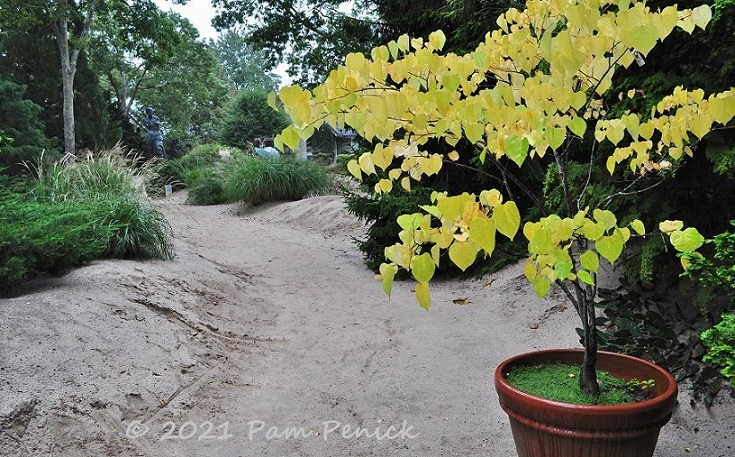
Walking into the garden, you find yourself on a sandy path surrounded by beachy dunes — a humorous reminder that the Atlantic Ocean is just three miles away. It’s a bit of manmade fancy created from the excavated soil for the house. Rather than pay to haul the stuff away, Larsen turned it into a striking feature that anchors the garden to its place.
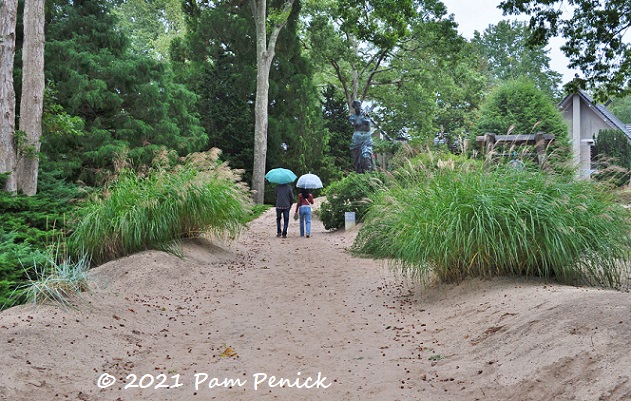
Tall ornamental grasses bend and sway along the dune ridges, hiding and revealing the entry garden. In the distance you catch a glimpse of a tall female figure…
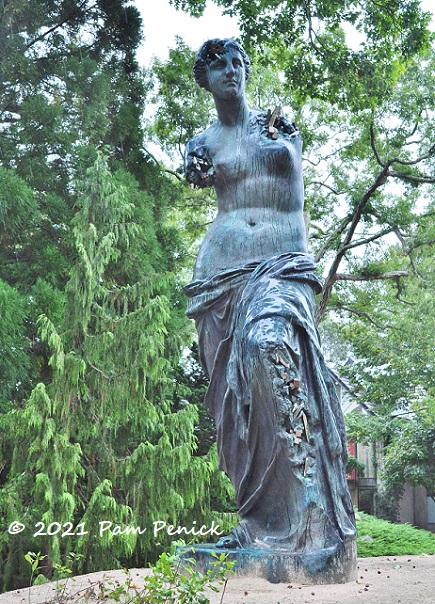
…a sculpture called Bronze Eroded Venus de Milo by Daniel Arsham.
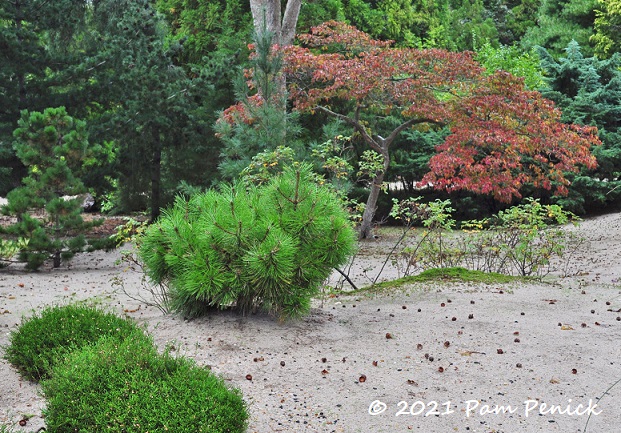
A bit of fall color in the dune garden
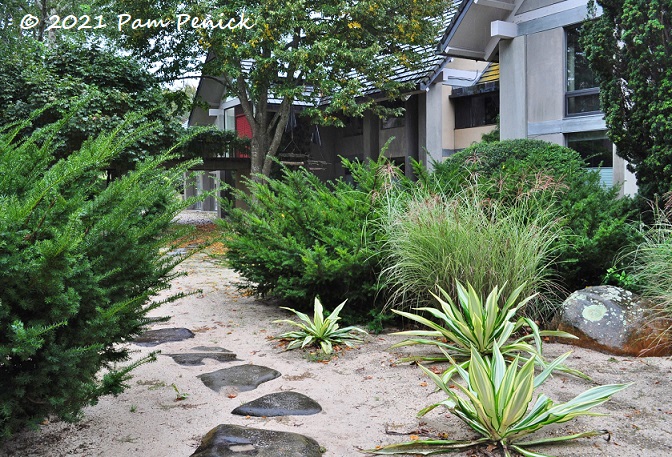
Near the house, black stepping stones lead the way through junipers, grasses, and, I think, furcraeas.
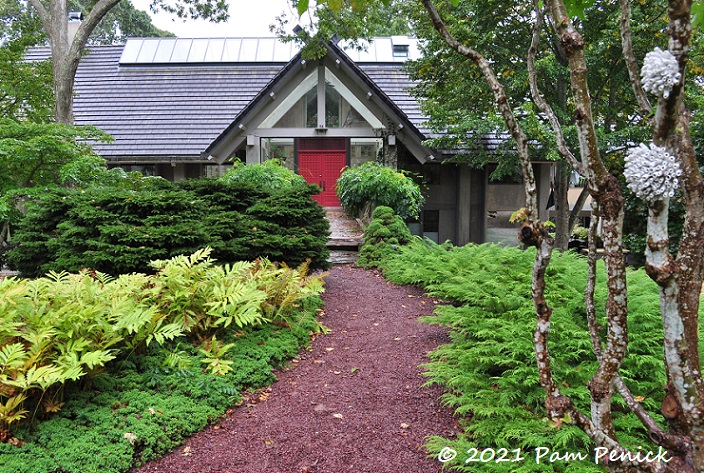
Red doors beckon under the house’s gabled entrance, reached via a bridge to the upper level. Nearly the entire roof’s length is capped by skylights, which must flood the interior with light. The 13,000-square-foot home’s design was inspired by ancient shrines in Japan, a country Larsen visited many times, and which informed not only the design of his home but his gardens. These depend not on flowers but structure, texture, and shades of green, with bones that look just as good in winter as in summer leaf.
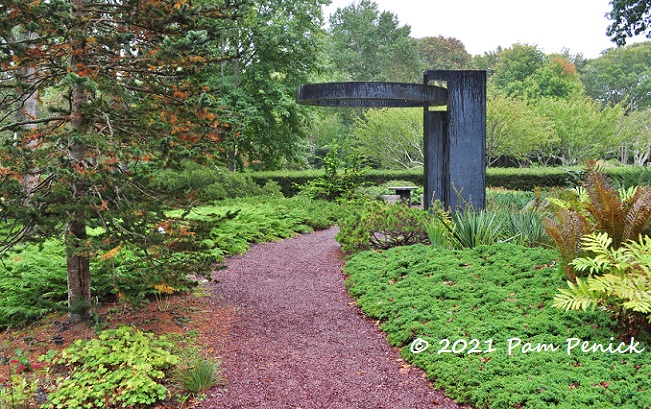
Following a mulched path around the house, I encountered Eye of the Ring by Takashi Soga, its chunky horizontal band seeming to float on its tether.
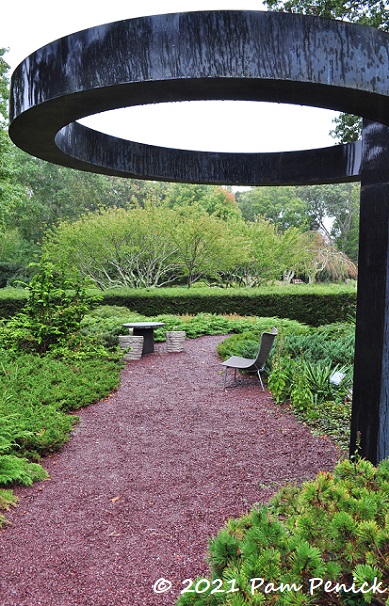
As I’d see throughout the garden, chairs and stools invite you to sit and stay a while.
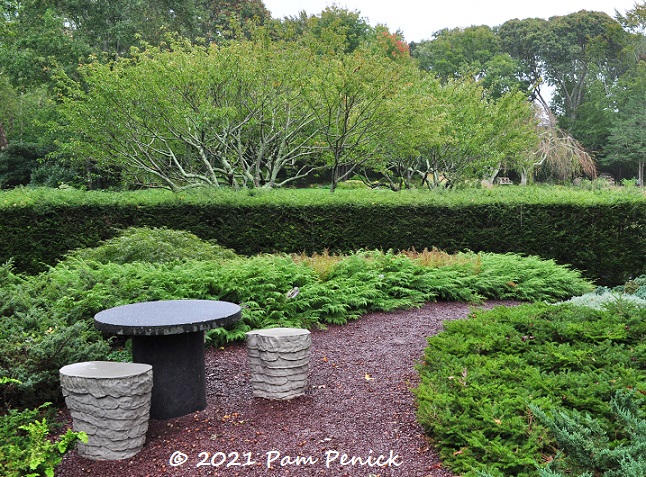
Pavilion garden
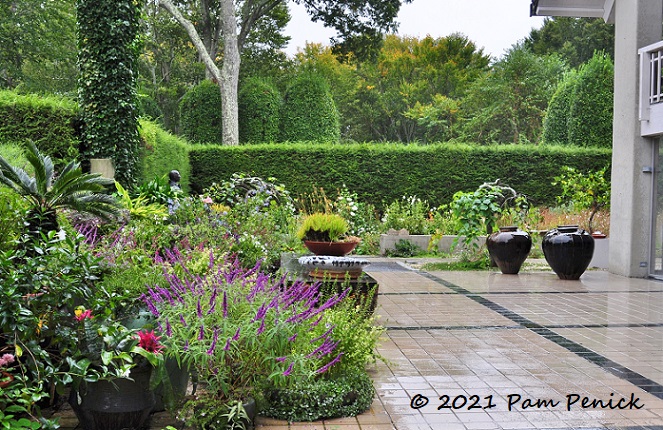
At one end of the house, the Pavilion garden comes into view. Potted perennials and tropicals flower along a tall hedge, which hides the view beyond.
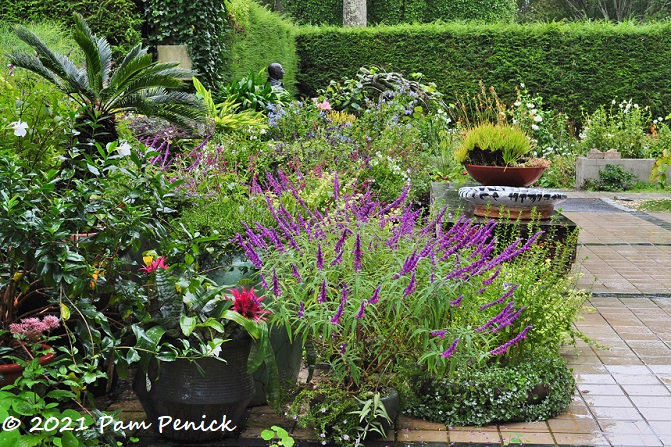
I enjoyed seeing Texas favorites Mexican bush sage (Salvia leucantha) and bulbine flowering happily here, with shell ginger and sago palm joining the subtropical party in back.
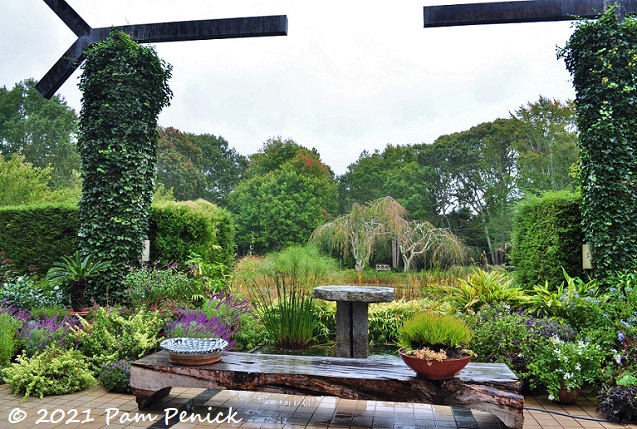
And now, look left — wow! Twin vine-cloaked pillars support Y-shaped beams. They frame a view of a large pond and shapely weeping trees on the far side. In the foreground, a raw-edge wooden bench topped with ceramic bowls and a stone birdbath-style fountain help focus the view. Behind me, a second-story terrace on the house overlooks this composition.
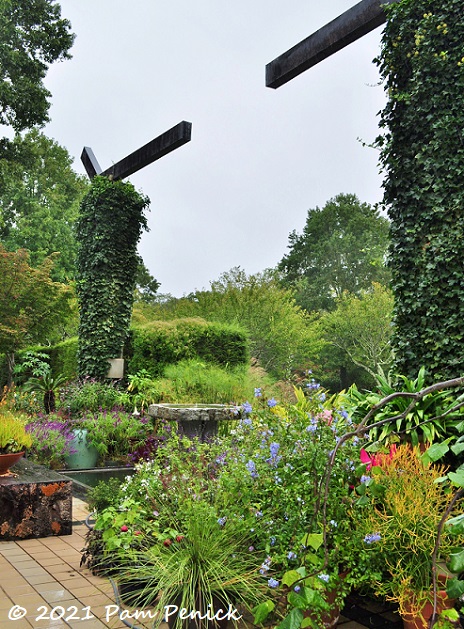
The Y-shaped pillars echo rafters extending out from the house, which you’ll see from a different angle in Part 3 of my tour.
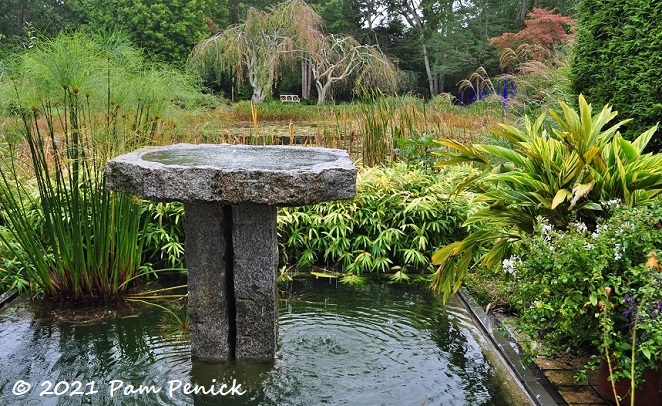
The stone fountain drips water into a small rectangular pool. Beyond, grasses in autumn’s tawny hues ring the pond.
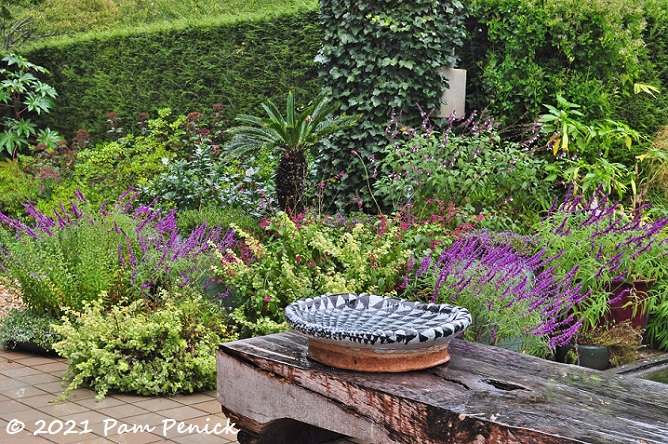
Salvias, a sago palm — it almost looks like home except for that feathery green hedge.
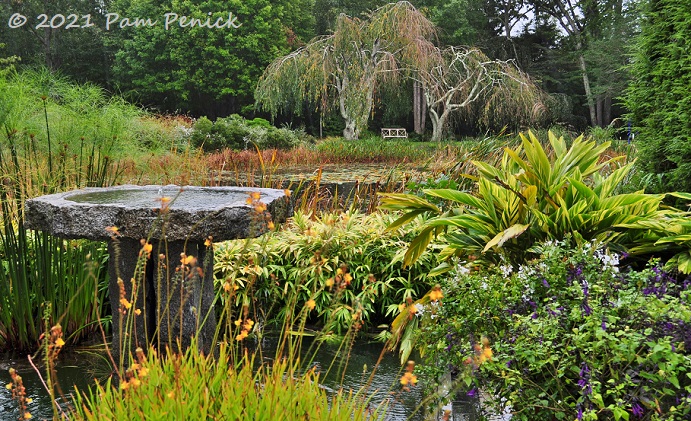
I love the color harmony here, starting with the orange bulbine and stretching across yellow-variegated shell ginger to the burnt orange of pond grasses and tan weeping trees.
Scree garden
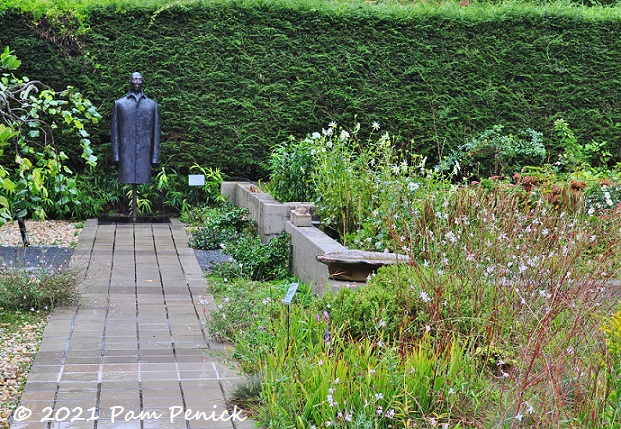
Continuing around the house, you come to the Scree Garden, with meadowy plants that appreciate gravelly soil.
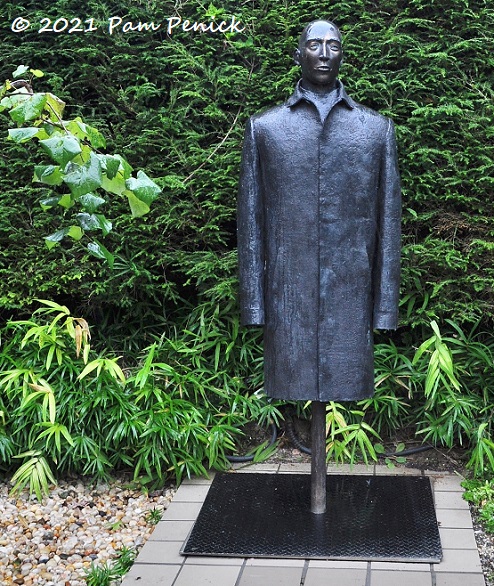
Idol by Judith Shea stands watch. I read that this sculpture and others of mannequins in business wear, their eyes lifted to the sky, were a response to 9/11. Shea was living near Ground Zero on that day.
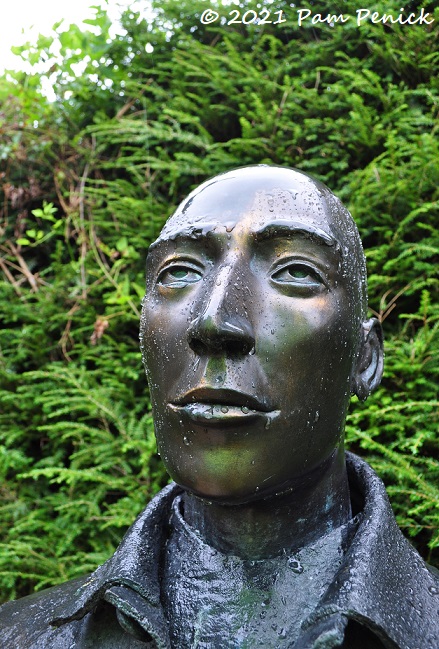
Tears in rain
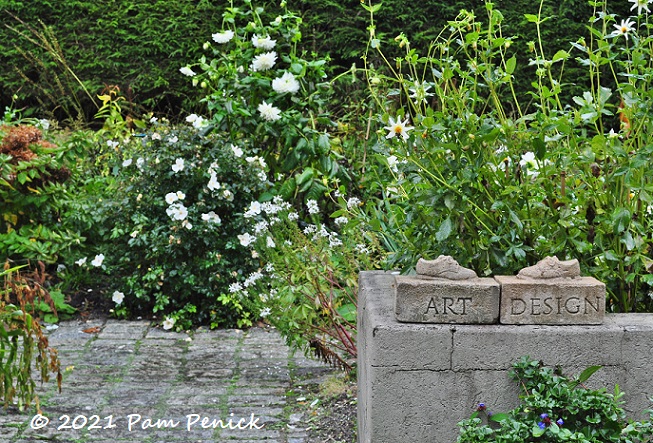
A sunken garden with bookend-like blocks that proclaim “Art” and “Design”
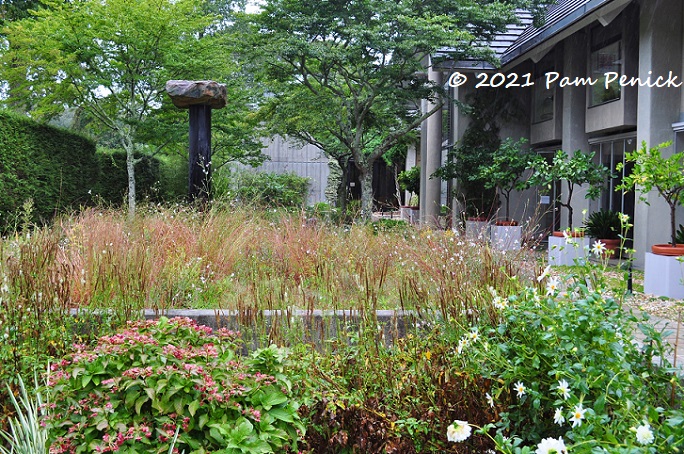
The lovely scree meadow runs the length of the house — which is very long indeed — facing banks of windows.
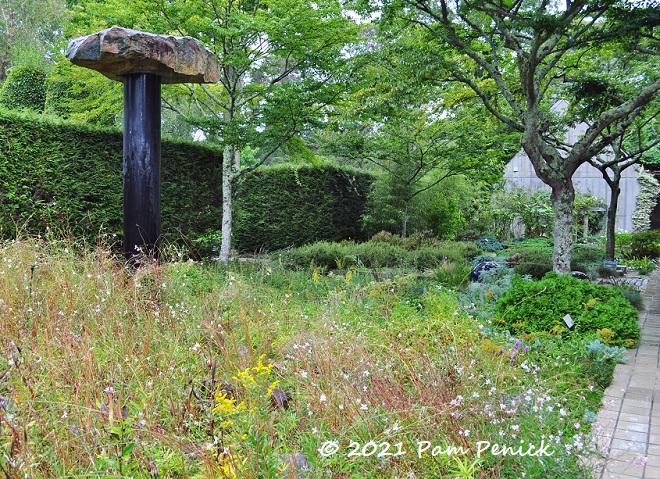
Another work by Takashi Soga, Floating Rain, stands tall in the meadow, its boulder-cloud balanced on a rain-slicked pedestal. A cross-path leads through the hedge to the next garden room.
Lap pool and tropical rill
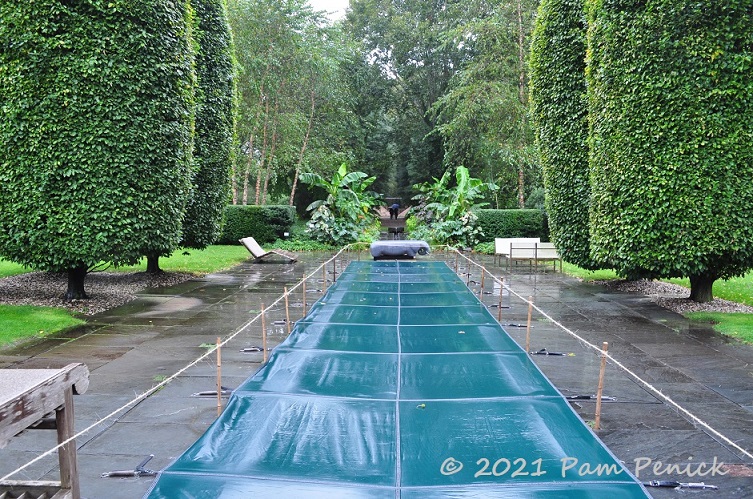
Formal framing with pairs of clipped hornbeams leads the eye out from the house along a long axis. Unfortunately the lap pool was covered for the season, so I had to imagine the effect of a summertime visit.
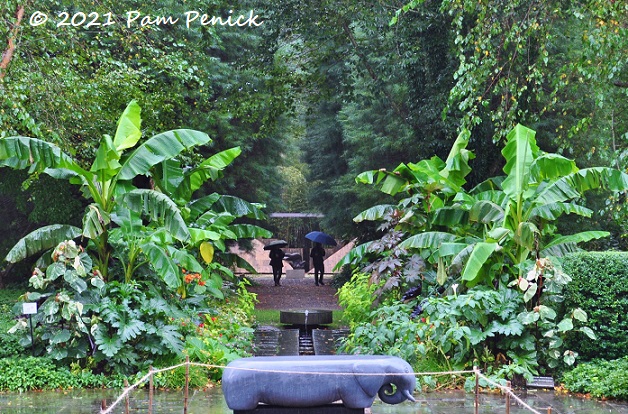
At the end of the pool, a sleek elephant bench offers a place to sit and enjoy the continuing view through a tropical garden.
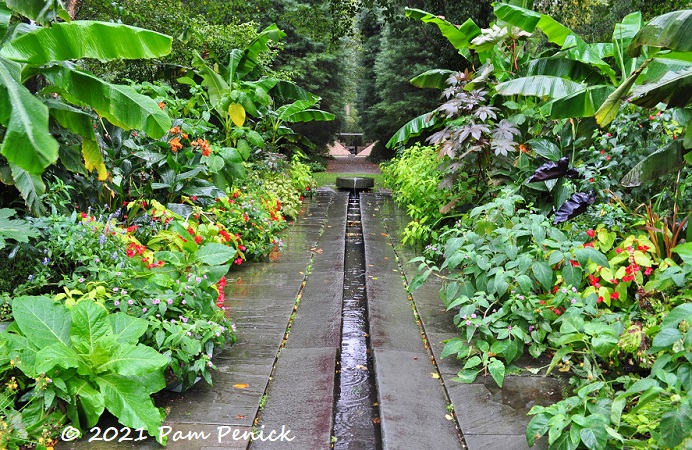
Bananas and flowering annuals flank a long rill that ends in a round millstone-style fountain. Beyond that, two sculptures — Tumbling Woman and Bridge — attract the eye to the far end of this axis. But I’ll save that for my next post. There’s still a lot to see here.
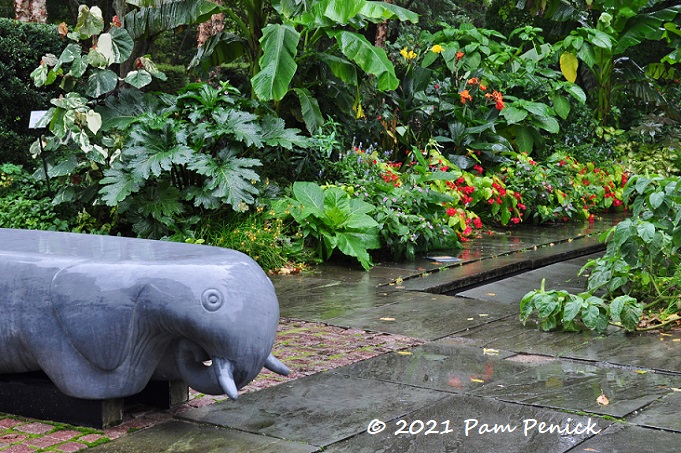
The elephant bench by Judy Kensley McKie makes a fun addition to the tropical garden.
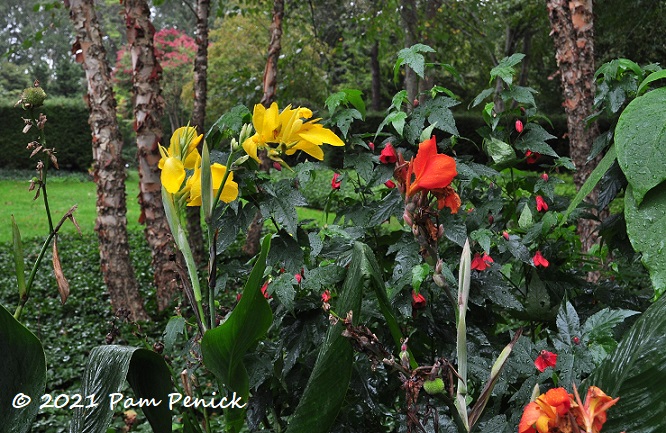
De Kooning lawn
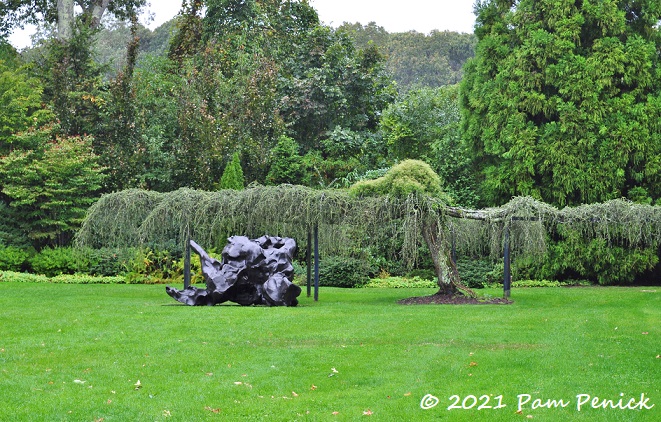
But let’s back up a bit. As you walk along the lap pool, views extend to the right and left. On the right an expansive lawn terminates at a horizontally trained weeping conifer– LongTree? — and a Willem de Kooning sculpture, Reclining Figure.
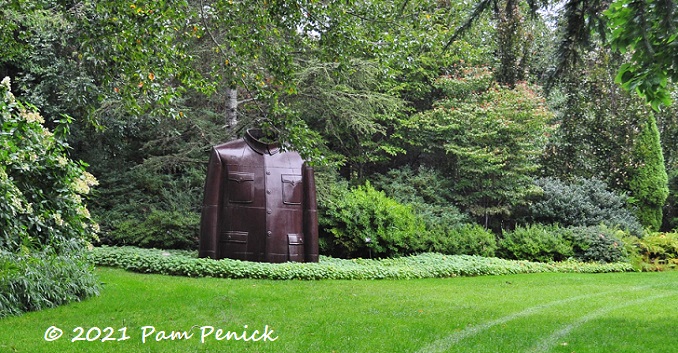
The monumental Legacy Mantle (Mao Jacket) by Sui Jianguo stands nearby, at a path leading into a woodland garden.
Hornbeam allée and sculpture court
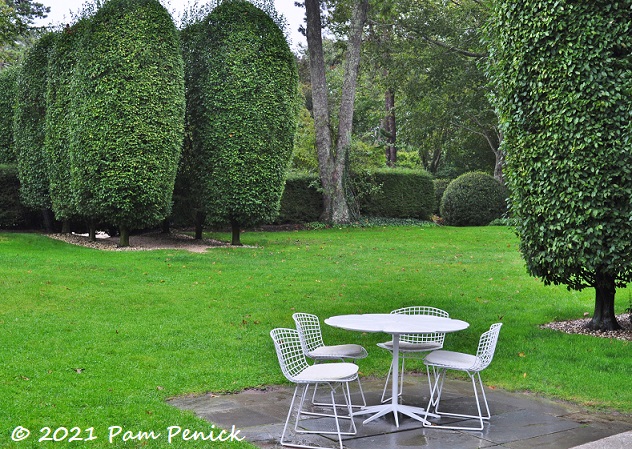
At left of the lap pool, the clipped hornbeams framing the pool reveal themselves to be part of a stuttering allée (with intentional gaps) running crosswise on another long axis.
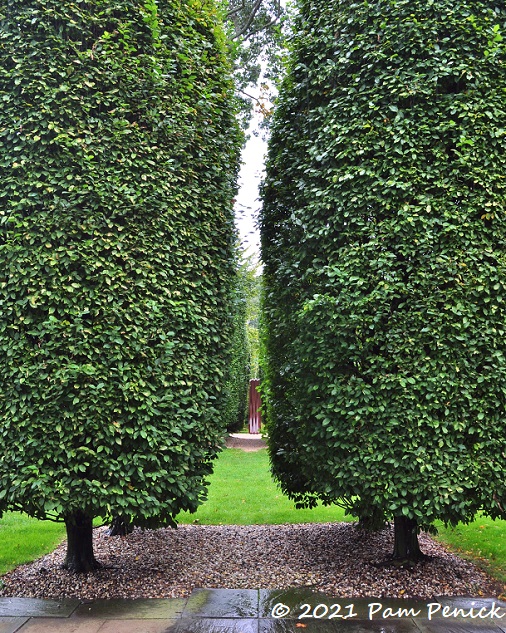
The hornbeam allée frames a very narrow view of sculpture in the distance…
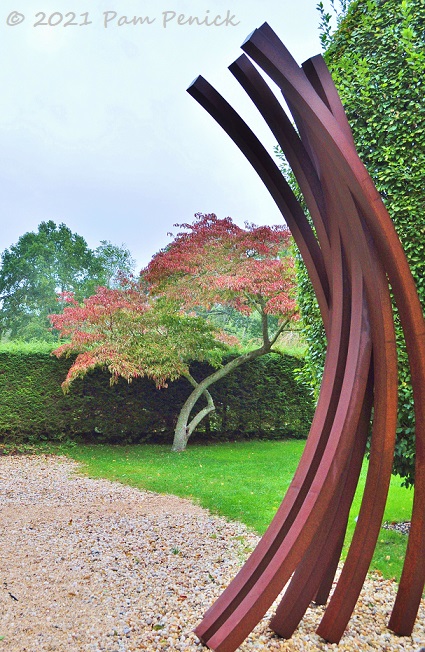
…curved steel arcs by artist Bernar Venet. I love its juxtaposition with the reddening tree behind it.
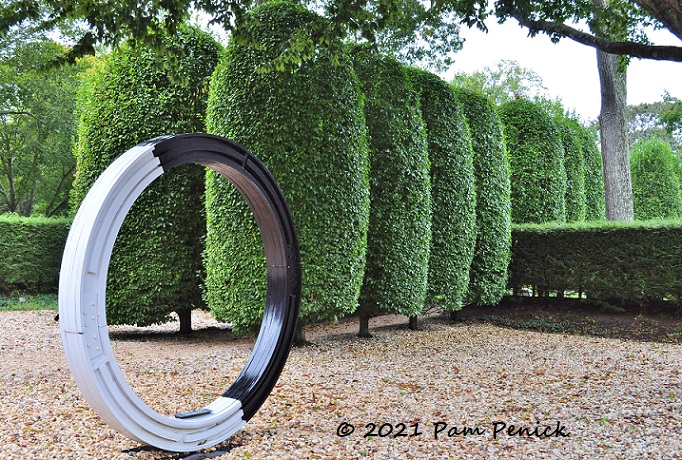
Mandala by Tony Rosenthal also serves to frame views from different angles. The strong geometry of both pieces complements that of the allée.
Black Mirror pool
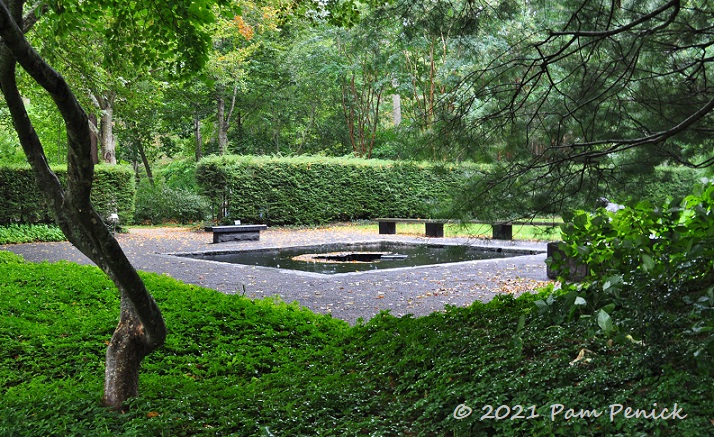
Not far from the exuberance of the tropical rill, a more solemn space appears, entirely green and serene. In the center Black Mirror, a rectangular pool designed by Larsen, draws you in.
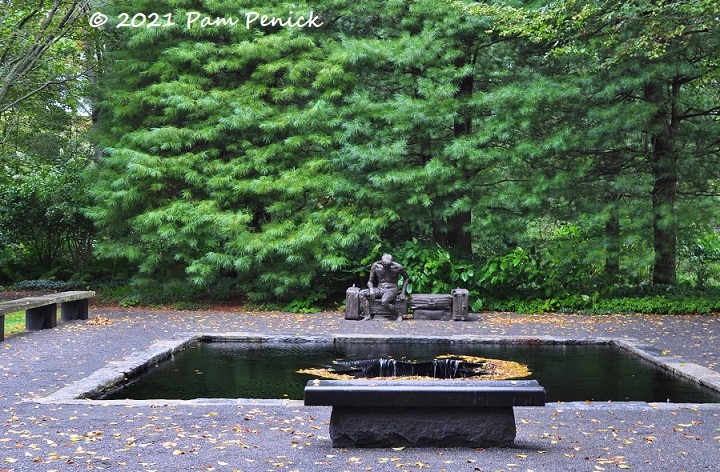
Black Mirror’s dark water spills into a cross-shaped well, reminding me of the 9/11 Memorial in New York City.
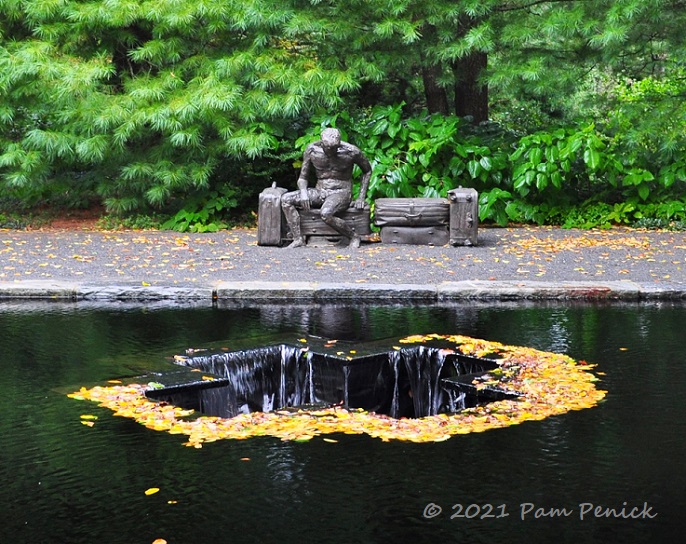
On one side of the pool, a bowed man sits on a pile of worn suitcases — a sculpture titled In Transit by Yoan Capote. Perhaps because Black Mirror reminded me of 9/11, I didn’t associate In Transit with immigration and displaced peoples. Rather, my mind went to thoughts of mortality.
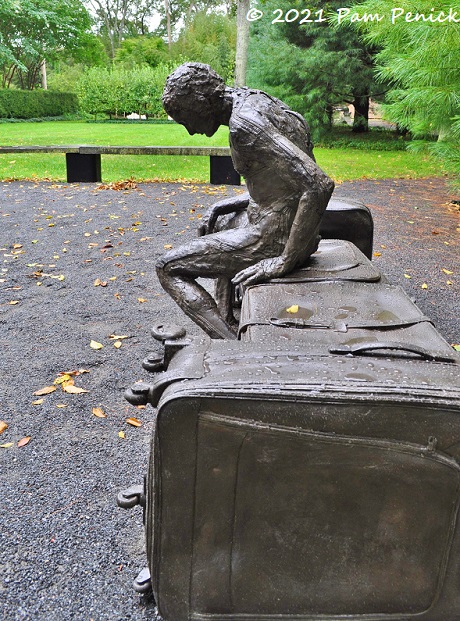
He seemed to me to be in-transit between earthly and heavenly realms, waiting to be plucked from the baggage of life. A bit maudlin perhaps, but that’s where thoughts can lead on a quiet autumn afternoon in Year 2 of a global pandemic. At any rate, I love a garden that evokes strong emotions, and clearly LongHouse was going to be one of those.
Up next: Part 2 of my ramble through LongHouse Reserve, including a woodland garden, more thought-provoking sculpture, and Larsen’s famous Red Garden. For a look back at Part 1 and Part 2 of my tour of Madoo, click here.
__________________________
Digging Deeper
Need design help with your yard? Hire me as your personal garden coach! Maybe you need replacement plant ideas after the big freeze. Or maybe your landscaping has grown tired, and you want fresh curb appeal. Or perhaps you’re ready to get rid of some lawn and create a pollinator garden, bird habitat, or hangout space for you and your friends. I’m here to help! Contact me to let me know what’s going on, and let’s figure it out together. My range is Austin and suburbs within a 25-min. drive of NW Austin, but I’m flexible and can travel farther with a surcharge, so let me know where you are. Weekday morning appts. only.
Come learn about gardening and design at Garden Spark! I organize in-person talks by inspiring designers, landscape architects, authors, and gardeners a few times a year in Austin. These are limited-attendance events that sell out quickly, so join the Garden Spark email list to be notified in advance; simply click this link and ask to be added. Season 8 kicks off in fall 2024. Stay tuned for more info!
All material © 2025 by Pam Penick for Digging. Unauthorized reproduction prohibited.


I have questions…I can’t actually see the sculpture in the photo under the title “Deep Kooning Lawn”. You wrote it’s titled “Reclining Figure” but from far away, that’s not what it looks like. Is there a person somewhere in it? It’s intriguing. (Looks like a magnificent tree stump/roots from far away.)
I particularly like the sculpture “In Transit”. It could bring to mind a variety of different meanings dependent on the viewer. It is extremely cool!
I look forward to Part 2.
That tree-stump-looking thing is actually the de Kooning piece, Laura. It’s an abstract figure, and I didn’t get a closer photo. But you can see another edition of the work here, in better detail: https://hub.jhu.edu/2013/10/01/de-kooning-sculpture-homewood/
There are so many great works to enjoy at LongHouse. I look forward to sharing more in part 2!
I live on Long Island and have never visited this wonderful place. I have only heard about it from one other person and it seems to be one of the best kept secrets. Your photographs speak words. After seeing this, I need to put this onto my definite to do list for the spring! Thank you for sharing!
Lee, I envy you the opportunity to visit LongHouse regularly through the seasons. You must go! I understand the board’s aim is to make LongHouse more than “just” a garden and plan to turn the house into a museum. It will be interesting to hear how it all evolves without its founder. I hope they can keep the creative spirit that was evident throughout the garden.
As someone who has a textile design degree, Larson is one of my gods. I have books about him and by him, but have never seen so many fabulous shots of the garden. I am in heaven with this post and can’t wait for the others. Thanks so much.
I’m glad you enjoyed the garden views, Linda. I have much more to share!
I thought about you while writing this post. I didn’t know anything about Larsen, had never even heard of him, before visiting his garden. But I remembered your comments about his influence on you and so spent time to learn more about him. He was quite a remarkable person. Thanks for spurring me to dig deeper.
What a wonderful surprise to discover this garden! There’s a lot to love here, although I could do with a little less of the artwork, as you might have guessed 😉
Hah, I’m sure! In this garden, however, the plants and art go hand-in-hand.
Wow! Such a perfect melding of garden and art. Often sculpture gardens are minimalist landscapes but this is lush and lovely. Thank you.
I agree, Janet, and that’s pretty much what I expected from the online descriptions of LongHouse as a sculpture garden. I was excited to discover the gardens are very much not an afterthought.
It’s an inspiring garden. I thought the sculpture was generally well integrated into the garden settings. Although I prefer abstract pieces in a garden setting, the sculptural figures were nonetheless engaging. I look forward to the next 2 posts on your visit.
Some of my favorite pieces were spheres by Grace Knowlton, which you’ll see in the next two posts.
Wow! What an amazing place; I’m so glad you found it. That opening shot, or the one later down with the bulbine, is just gorgeous to my eye. The sculpture is thought-provoking, too, and there’s something captivating about the Black Mirror pond. Lovely garden, and I look forward to the future installments.
Thanks, Maggie. I’m glad you enjoyed it!
Pam,
You lead such a wonderful life. Thank you for sharing it with us.
Jane, thank you. Your comment reminds me to be grateful. I have the usual heartbreaks, of course, but I do try to seek out the beauty in the world — there’s so much to discover — and delight in sharing it here at Digging.
I especially loved the dune path-such a sense of place and I’d really never seen anything quite like it before in a public garden. I seem to recall that this garden was on on our ‘maybe if we have time ‘ list but one of the garden owners we visited earlier that day highly recommended it. Maybe the Landcraft Environment dudes ? Anyway I’m so glad we decided to take their advice-it turned out to be one of my favorites on LI. Looking forward to your next posts !
Thanks, KS. The dune path creates such a wow moment as you enter. It really set the tone that this was going to be an usual and creative garden. Did you end up writing a blog post about your own visit to LongHouse? I’d love to read it.
Side view of In Transit looks very young, a teenage survivor of a lost family?
I could see that interpretation, Diana, although to me he looks bowed in maturity.
Pam, I’m catching up on old email/blog posts and just read this first piece about Longhouse Reserve. I visited this amazing place in 2015, when I travelled through Long Island with my sister. We both loved the garden, the art and the experience of being in this very special place. One of the intriguing things is to compare my photos with yours, to see what has changed in the intervening 7 years. There was a curving line of spheres of different materials leading through the Dune Garden, and a group of blue reed-like pieces by Dale Chihuly in the pond by the house. I assume neither is there now, or you would have photographed them. Black Mirror is still the same but the sculpture In Transit has replaced a sharply angled one by Ronald Bladen. That change has altered significantly the ‘feel’ of Black Mirror itself. I like both iterations but they evoke quite different emotional responses.
Now, on to reading parts two and three of this visit!
From the research I did on this garden, they change up the sculptures frequently, although some pieces do remain at the garden long-term. You’ll see the Chihuly reeds in my third post about LongHouse — still at the pond, but not right by the house.